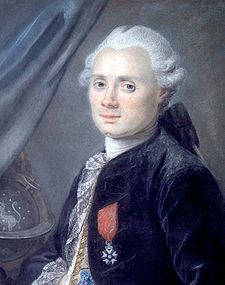- Charles Messier
-
Charles Messier 
Charles MessierBorn 26 June 1730
Badonviller, FranceDied 12 April 1817 (aged 86)
Paris, FranceResidence Paris Citizenship French Nationality French Fields Astronomy Known for Messier catalog Notable awards Cross of the Legion of Honor Charles Messier (26 June 1730 – 12 April 1817) was a French astronomer most notable for publishing an astronomical catalogue consisting of deep sky objects such as nebulae and star clusters that came to be known as the 110 "Messier objects". The purpose of the catalogue was to help astronomical observers, in particular comet hunters such as himself, distinguish between permanent and transient objects in the sky.
Contents
Messier's life
Messier was born in Badonviller in the Lorraine region of France, being the tenth of twelve children of Françoise B. Grandblaise and Nicolas Messier, a Court usher. Six of his brothers and sisters died while young and in 1741, his father died. Charles' interest in astronomy was stimulated by the appearance of the spectacular, great six-tailed comet in 1744 and by an annular solar eclipse visible from his hometown on 25 July 1748.
In 1751 he entered the employ of Joseph Nicolas Delisle, the astronomer of the French Navy, who instructed him to keep careful records of his observations. Messier's first documented observation was that of the Mercury transit of 6 May 1753.
In 1764, he was made a fellow of the Royal Society, in 1769, he was elected a foreign member of the Royal Swedish Academy of Sciences, and on 30 June 1770, he was elected to the French Academy of Sciences.
Messier discovered 13 comets [1]:
- C/1760 B1 (Messier)
- C/1763 S1 (Messier)
- C/1764 A1 (Messier)
- C/1766 E1 (Messier)
- C/1769 P1 (Messier)
- D/1770 L1 (Lexell)
- C/1771 G1 (Messier)
- C/1773 T1 (Messier)
- C/1780 U2 (Messier)
- C/1788 W1 (Messier)
- C/1793 S2 (Messier)
- C/1798 G1 (Messier)
- C/1785 A1 (Messier-Mechain)
His catalogue
The first version of Messier's catalogue contained 45 objects and was published in 1774 in the journal of the French Academy of Sciences in Paris. The final version of the catalogue was published in 1781, in Connoissance des Temps for 1784.[2] The final list of Messier objects had grown to 103.
On several different occasions between 1921 and 1966, astronomers and historians discovered evidence of another seven deep-sky objects that were observed either by Messier or his friend and assistant, Pierre Méchain, shortly after the final version was published. These seven objects, M104 through M110, are accepted by astronomers as "official" Messier objects.
The objects' Messier designations, from M1 to M110, still are in use by professional and amateur astronomers today.
The catalogue is not organized scientifically by object type or by location, as the later New General Catalogue would be. Nonetheless, the Messier catalogue comprises nearly all the most spectacular examples of the five types of deep sky object – diffuse nebulae, planetary nebulae, open clusters, globular clusters and galaxies – visible from European latitudes. Because these objects could be observed with the relatively small-aperture refracting telescope (approximately 102 mm, or four inches) used by Messier to study the sky, they are among the brightest and most attractive deep sky objects observable from earth, and are among the most popular targets for visual study and photography available to modern amateur astronomers using larger aperture equipment. Furthermore, almost all of the Messier objects are among the closest to our planet in their respective classes, which makes them heavily studied with professional class instruments that today can resolve very small and visually spectacular details in them.
Many of the objects in the Messier catalogue were discovered by his assistant, Pierre Méchain.
The crater Messier on the Moon and the asteroid 7359 Messier were named in his honor.[3]
Footnotes
- ^ Maik Meyer. Catalog of comet discoveries
- ^ Charles Messier, 1781. Catalogue des Nébuleuses & des amas d'Étoiles. Connoissance des Temps for 1784 (published 1781), pp. 227–267 [Bibcode: 1781CdT..1784..227M].
"Original Messier Catalog of 1781". Original Messier Catalog of 1781. http://seds.org/messier/xtra/Mcat/mcat1781.html#messier1781. Retrieved 10 November 2007. - ^ Schmadel, Lutz D.; International Astronomical Union (2003). Dictionary of minor planet names. Berlin; New York: Springer-Verlag. pp. 592–593. ISBN 978-3-540-00238-3. http://books.google.com/books?id=KWrB1jPCa8AC&pg=PA592. Retrieved 9 September 2011.
Sources
- O'Meara, Stephen James (1998). Deep Sky Companions: The Messier Objects. Cambridge University Press.
- Charles Messier Biography at Students for the Exploration and Development of Space. Accessed July 2007
- Short biography of Charles Messier and history of the Messier Object Catalog by Jon Zander at OurDarkSkies.com . Accessed July 2007
- Life of a Comet Hunter: Messier and Astrobiology Professor Mark Brake and Martin Griffiths, Astrobiology Magazine European Edition, Spring 2007. Accessed July 2007
See also
External links
- Amateur Photos of Charles Messier Objects
- Messier Marathon Attempts to find as many Messier objects as possible in one night.
- New General Catalog and Index Catalog revisions NGC/IC Project is a collaborative effort between professional and amateur astronomers to correctly identify all of the original NGC and IC objects, such that the identity of each of the NGC and IC objects is known with as much certainty as we can reasonably bring to it from the existing historical record. Accessed July 2007
- Clickable table of Messier objects
- Charles Messier at Find A Grave
- Charles Messier explains his catalog
Categories:- 1730 births
- 1817 deaths
- People from Meurthe-et-Moselle
- Comet discoverers
- French astronomers
- Fellows of the Royal Society
- Members of the French Academy of Sciences
- Members of the Royal Swedish Academy of Sciences
Wikimedia Foundation. 2010.

